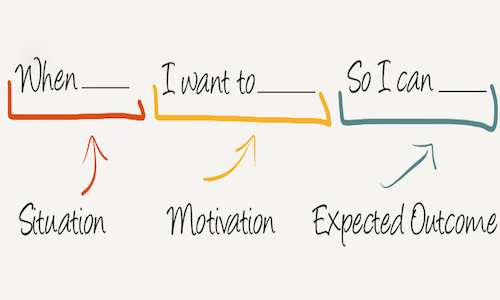Shiny objects are the features you release that arn’t supported by evidence the customer needs them.
Airwallex’s Richard Jeremiah gives his perspective on how Product Teams should triage the firehose of ideas, feedback and opinions that all compete for precious sprint resources.
In this short video, Contextual’s David Jones asks Airwallex’s Richard Jeremiah how they reduce down all features into the things that get built.
He cautions that all product teams have a tendency to “Veer off the path” :
- moving away from (measurable customer) “outcomes” to “output”.
- Teams often shy away from uncertainty to just making and releasing the new shiny objects.
Outcomes vs Output
For Airwallex and “Outcome” is focussed on customer value – this generally relates to an Objective or a Key Result in an OKR.
In contrast, an “Output” is just the result of keeping busy. This is often features that are built in isolation from customer needs. In other words, output is that new shiny objects are something the team saw in a designer’s blog post or a competitive product.
The challenge, Richard says is that “Outcome” is always way less certain than “Output” – an output is a known quantity, its just a matter of applying the resources and getting it released.
An Outcome requires much more validation and rigour to verify:
- Are we building the right things?
- Are shipping valuable things for customers
“Solving core customer problems is one of the great challenges of Product Development.” and “Get inside the head of the customer.”
Triaging competing requests
At the top of the product teams work funnel is a massive amount of options:
- Bugs to be fixed
- Technical debt to be re-factored. Scale and stability issues.
- Customer feedback captured in Zendesk etc
- Sales people claiming its imperative to implement ABC feature for XYZ prospect
- Team opinions
- New shiny objects and technologies
- validated feedback from customers
- results of experiments, hacks
- biased opinions from the product manager.
- and that old favourite….the fly-by CEO visit about something that’s been bugging them.
There is a lot to be triaged and having something like RICE is fine, but it’s rudderless.
Similar to what Zip‘s Patrick Collins advised the sprint needs to be filled with jobs that match to the customer and company imperatives.
Specifically, Richard says: Strategy—>OKRs—>Measures that reflect toward an Objective or Key Result/Outcome.
This top-down approach leads to using tools like Teresa Torres’ “opportunity solution trees” to ideate a range of possible technical and non-technical solutions.
From there a weighting or “sizing” (Richard’s term) for each initiative is used as another filter for what makes the sprint.
Summary
The summary is that new shiny objects will always be tabled as solutions to product problems or opportunities.
Its correct – the shiny objects may be a terrific solution! But you MUST run them:
a) through the lens of the customer’s needs
b) the organisational priorities and OKRs.
Banner Image credit
Transcript
00:03 – some of the lessons that i’ve
00:04 – learned over my career but it’s very
00:06 – very easy for
00:07 – teams to veer off the path away from
00:10 – outcomes towards output
00:11 – it’s very easy to veer off the path of
00:14 – experimentation uncertainty and trying
00:16 – to nail down something that is certain
00:18 – which is
00:18 – in many cases look at this shiny thing
00:21 – that i’ve built
00:22 – and so trying to embed that into your
00:25 – day-to-day
00:26 – um check-in with the team i think so
00:29 – anyway you’ve got these squads
00:31 – how do you actually make sure you’re
00:32 – building something that people actually
00:34 – want
00:35 – so yeah i mean that’s a that’s a big
00:38 – question
00:39 – um and it’s it’s really challenging i
00:42 – think i think this is
00:44 – you know making sure you’re shipping
00:45 – value to customers is the
00:47 – it’s one of the defining aspects of
00:49 – whether you’re not gonna be successful
00:50 – as a business
00:51 – um i mean that’s that’s like are you
00:54 – well suited as a business to do
00:55 – to do that and all those stuff there’s
00:56 – lots of other questions but one of them
00:58 – is generally
00:59 – are you solving a core customer problem
01:01 – is
01:02 – one of the great challenges of product
01:04 – product development look our focus is
01:07 – and my focus has been for a long time um
01:10 – i i spoke previously it’s all about
01:12 – focusing on the outcome
01:14 – and not focusing on output that’s the
01:16 – that’s the key
01:17 – um it’s very natural as human beings
01:20 – that we want to focus on
01:22 – the output and not the outcome and one
01:24 – of the reasons for that is output is
01:25 – certain if you
01:26 – if you apply effort you’ll get you’ll
01:28 – have something to show
01:29 – for it in terms of that you know it
01:32 – could be
01:33 – whether it’s a new page that you’ve
01:34 – created whether it’s an experience
01:36 – enhancement thing you’ve done whether
01:37 – it’s a new feature
01:38 – that’s available on your on your
01:40 – platform you’ll have something to show
01:41 – whether that thing matters or not that’s
01:43 – the question right and so the
01:44 – outcome is always way less certain and
01:47 – we have a natural information as people
01:49 – to want to you know shy away from that
01:51 – uncertainty towards something that’s
01:52 – certain
01:54 – you have to be relentless in that focus
01:56 – on the outcome
01:57 – and that outcome could be whether it’s a
01:59 – commercial outcome that you’re trying to
02:01 – achieve by a meeting a need or a
02:03 – customer need itself
02:05 – you know that’s where your focus has got
02:06 – to be so for me
02:08 – trying to ensure that you’re shipping
02:09 – value it’s all about
02:11 – focusing on the outcome um and
02:15 – and then you know if the outcome is
02:17 – customer related
02:19 – ah yeah so you sort of threw that in at
02:21 – the end but it sounds like the most
02:22 – important thing
02:23 – so you you know what goes in the top of
02:25 – the funnel
02:26 – is a whole bunch of things you’ve got
02:28 – opinions you’ve got sales people walking
02:30 – back saying
02:31 – you know they’ll come on board if you
02:32 – actually develop this feature
02:34 – uh you know you you know that sales
02:36 – people are always dragging in between
02:38 – you know bits of roadkill they say that
02:40 – this is definitely the one that’s going
02:41 – to
02:42 – break the you know it’s really going to
02:44 – the company will break out
02:45 – you’ve got opinions around particular
02:46 – things and then you’ve got disciplines
02:48 – and customer
02:49 – so how how are you feeling the top of
02:51 – the funnel and then how are you triaging
02:53 – that to get to this
02:55 – output that’s actually used by a
02:57 – customer
02:58 – used by a customer yeah sure or even
03:01 – valued
03:02 – valued by a yeah yeah so
03:05 – we um the general the general approach
03:07 – and i
03:08 – alluded to this before with you know we
03:10 – have a strategy we have a set of okrs
03:13 – that that then outlines um you know
03:16 – here’s some some measures we’re going to
03:18 – try and deliver over the course of the
03:19 – quarter
03:20 – and those measures reflect progress
03:22 – towards an outcome or an objective
03:24 – right what we take from there is trying
03:26 – to understand
03:27 – what are the various opportunities there
03:29 – are to better serve the customer in a
03:31 – way
03:32 – that’s going to drive that particular
03:33 – key result and
03:35 – getting an understanding of that is all
03:38 – about trying to get
03:39 – under or inside the head of the customer
03:42 – and there’s a lot of ways to do that
03:45 – and you know you have to you want to use
03:47 – all the tools you’ve got your disposal
03:49 – sales people they are one of the tools
03:51 – yes they have
03:52 – they’ll have a lot to say that
03:54 – oftentimes will be focused towards
03:56 – a feature and a solution and they’ll
03:57 – tell you about the solution
03:59 – i mean one of the things is to try and
04:01 – step back from that and say well hang on
04:02 – what’s this solution actually trying to
04:04 – achieve
04:04 – and refer back from that some of it is
04:06 – talking to those sales people all those
04:07 – customers support people
04:08 – and just taking on the journey to say
04:10 – hey when you talk to your customers
04:12 – next time they come up with a solution
04:14 – can you ask why they want to do that and
04:16 – actually try and work with your customer
04:17 – support team to drive better customer
04:19 – insights on the
04:21 – the why for the customer as opposed to
04:23 – what they want because
04:24 – you know if you ask a customer what do
04:25 – you want they’ll ask for you know
04:27 – classic saying i want a faster horse not
04:29 – i want a
04:30 – motor vehicle so it’s about trying to
04:33 – use
04:34 – as many of the avenues that you’ve got
04:37 – to get customer insight and that can be
04:39 – you know talking to customers watching
04:41 – customers engaging with customer support
04:43 – team as i’ve said you can
04:45 – um and in fact you can do that yourself
04:47 – you know one of the things i used to do
04:49 – a little bit of secret to get onto our
04:50 – zendesk and start seeing what customers
04:52 – are saying and trying to understand
04:54 – what’s going on for them uh and again
04:57 – you know
04:57 – use your sales people they have a lot of
04:59 – insight they’re coming to customers all
05:01 – the time
05:02 – but what you need to do is you need to
05:03 – bring that back to try to understand the
05:05 – customer’s motivations trying to
05:06 – understand their needs
05:17 – okay so that’s a discipline to actually
05:19 – just basically look at it through the
05:20 – lens and i guess what are using customer
05:22 – interviews for that or
05:24 – yeah so there’s a mix i mean the way
05:27 – the way you know uh structured it and
05:30 – the way we’re structuring it and while
05:31 – it’s the framework we’re using is jobs
05:33 – to be done
05:34 – um we at seek
05:37 – out a thing called a mental model which
05:39 – is a more detailed deep dive than jobs
05:41 – to be done into very
05:42 – difficult tasks and that that is
05:44 – essentially that mental model is
05:45 – essentially a shared understanding of
05:47 – the customer
05:48 – and what is put against that mental
05:50 – model the evidence that used to
05:51 – construct that at
05:52 – customer interviews uh customer support
05:55 – insights
05:56 – um you know experiment data behavioral
05:59 – data on the platform like
06:00 – basically any data point you can get
06:02 – about the customer is used to help build
06:03 – out that shared understanding of how the
06:05 – customer
06:06 – thinks facts their motivations what
06:07 – they’re trying to achieve et cetera et
06:09 – cetera
06:09 – so is a mental model an intersection of
06:12 – you know demographics slash personas
06:14 – and job to be done is that is it so yeah
06:18 – i mean you could segment the mental
06:19 – model
06:20 – based on the different personas um but
06:22 – really it’s just a more detailed view
06:25 – of jobs to be done you’re getting down
06:27 – to very discreet tasks as opposed to a
06:29 – job you know a job is
06:30 – a manifestation of multiple tasks it’s
06:31 – like subtasks and sub-sub-tasks it’s
06:33 – really really granular
06:35 – and it just essentially represents a
06:37 – shared understanding of the customer how
06:40 – we
06:40 – understand the customer’s motivations
06:43 – and what they’re trying to achieve
06:44 – through
06:45 – in this particular you know task






